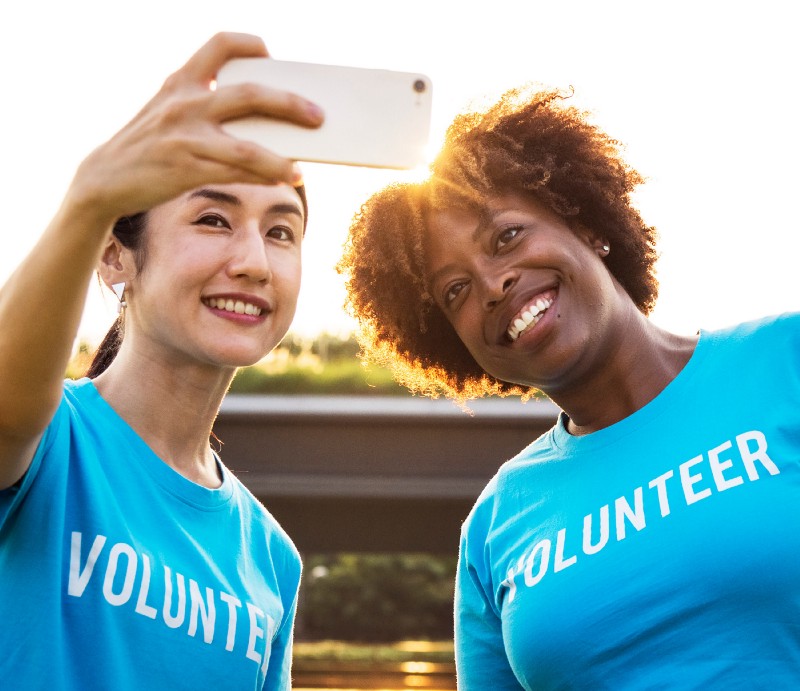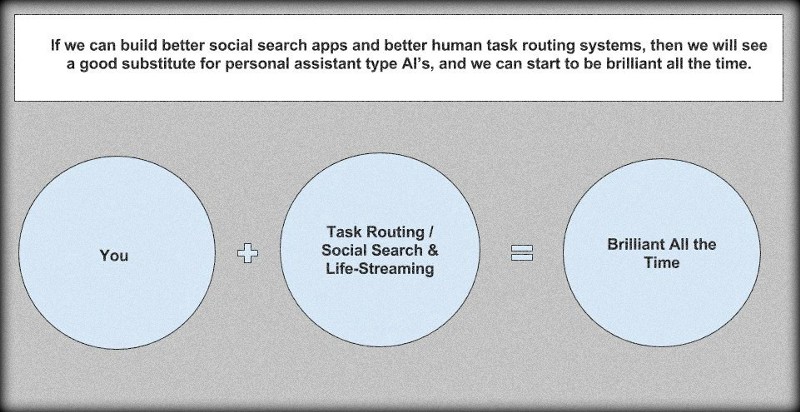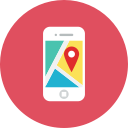
Let’s Start with a Short Story…
Social Search Takes a Walk
You are walking down a concrete path leading into the park, and you remember to put on your augmented reality (AR) / video-streaming glasses…when a question pops into your mind. You say the question out loud, “What kind of tree is that?” Immediately an image of a smiling woman pops into the corner of your glasses’ AR-interface. It’s a profile picture, and under it is a text field which says, ‘Sarah, botany-geek’. And, there is more text under that which says, “Hi there. That looks like a type of eucalyptus. Did you know that there are more than 700 species of eucalyptus tree?” You respond with your microphone, “ did not know that… wow! Cool, thanks… The leaves have a wonderful smell, and I was just curious.” She sends back a quick message: “You are very welcome!”. Now, you continue on your walk. After a few minutes of walking, you notice your stomach grumble, and you are considering asking this social-search app on your glasses to recommend a good vegan BBQ-sandwich in your area (hoping that someone is active on the network that had one) … but then you see something. A child is lying on his back, on the edge of a soccer field, and his face is turning blue. Apparently, there is a large jawbreaker lodged in his throat. There are a bunch of other kids standing around him, and they are all freaking out! You don’t know CPR, but you remember this new social search app has 911 operators on-call for emergencies. You say into your microphone, “9–1–1 emergency!”, and immediately you are video-chatting with an EMT in your glasses, getting visual-directions-and-examples of exactly what to do. You manage to follow all the steps for CPR that were illustrated for you correctly, and “POP!”, out-comes the jawbreaker… The child takes a HUGE gasp of air. Everyone lets out a sigh of relief. That kid was darn-lucky you were wearing those glasses! The nearest emergency response team to help him would have been over 15 minutes away….
What is Social-Search?
As explained in Ch 1 of this book, social-search is a method of powering a search-engine using real-people to answer queries in real-time (or semi-real time).
And, since search-via-algorithm (i.e., normal search-engines), although getting better every year, are ineffectual much of the time, it’s a compelling idea.
Note: Social search is a phenomenon better known as “question and answer sites,” but social search goes beyond simple questions and answers. Currently, a handful of question-and-answer sites (Q & A Sites), (like Quora, Stack Overflow, and Yahoo Answers, etc.), have amassed large user-bases, and sites that facilitate seeking answers from the crowd continue to be popular.

That’s Nice and All, but Let’s Upgrade!
We can amp-up social-search / Q & A sites (and related services) in a number of ways using technology that we have today:
Live Video: By using live video-feeds from glasses with AR (augmented reality) capabilities, we can share our view of the here and now, (i.e., whatever has our attention at that moment, the audio too) while getting feedback on it from crowds of people or individuals. Real-Time Answers: Even without video or audio input (i.e., text only), for social-search to work, it must deliver results quickly. Fewer things are more fickle than the human attention-span. Also, to make judgments, we need to know answers quickly in order to act on time. By making a social-search engines that can guarantee quick answers from real human beings, we could have a really powerful tool on our hands. A Big Network: To ensure that a real-time social-search engine works, it will need people, preferably a lot of them! It would be best, then, to be able to tap into popular social-networking sites for this. That way, people with varying expertise can be found at all times to answer all the kinds of questions that show up. Different Options for Interacting: Not everyone will be able to broadcast video (sometimes called ‘life-casting’), or audio. Also, not everyone will be able to listen to you via audio, or view what you see through your video-stream, so there should always be a number of options for how to interact within a social-search community. This could include transcribing audio automatically using speech-recognition software, or having text be read out-loud (from the answers submitted to questions, etc) with a robot voice.

Ch2’s Logic: You + Task Routing/Social Search and Life Streaming = Brilliant All the Time
How Brilliant Can We Become?
With a tool like this in people’s hands (or in their eyes to be specific), we would all become brilliant all of the time as we listen to the crowd-powered agents whispering in our ears.
The following are the key things we will be able to know with a system like this (i.e., the things that will make us brilliant):

Facts: For facts that aren’t stored on some web-page, or facts that only a person would know, social-search is ideal.
“How many birds are sitting on the Robocop Statue in Detroit at this Moment?”
Judgments: An answer that requires a human’s opinion.
“Do you think my Halloween costume is offensive?”

Guidance: A question that requires someone to guide you through an action:
“How should I throw this boomerang so that it goes into the air at an angle and then comes right back to me (so I can catch it)?”
Experience: An answer that needs the perspective of someone who has gone through the same thing:
“Will this Slick-and-Slack oil-change place try to up-sell me? It’s the one in Dayton, Ohio.”
- Get information from people who have been where you are about to go.
- Ask people about a specific experience they’ve had at that place.

Hyper-Local Information: An answer that is time-and-location sensitive.
“How long is the line for the post-office in Arcadia, California right now?”
or
“Where’s s an example of really old crumbling sidewalk in this town? I need to take a picture of one for an art project.”

How it Could Bring Us into the Future Faster?
Armed with a robust social-search app in something like augmented reality glasses, the ability to quickly assess situations, get feedback, or inform your decisions will help the scientists, programmers, and leaders of today reach their visions for tech of tomorrow sooner.
Furthermore, it will give novices the ability to become (or at least act like) virtual Q&A angels on the shoulders of experts in the aforementioned professions.
As a final thought…
Why not connect to your fellow man the way you really want to… impersonally, and based on expediency, their expertise, and their reputation?